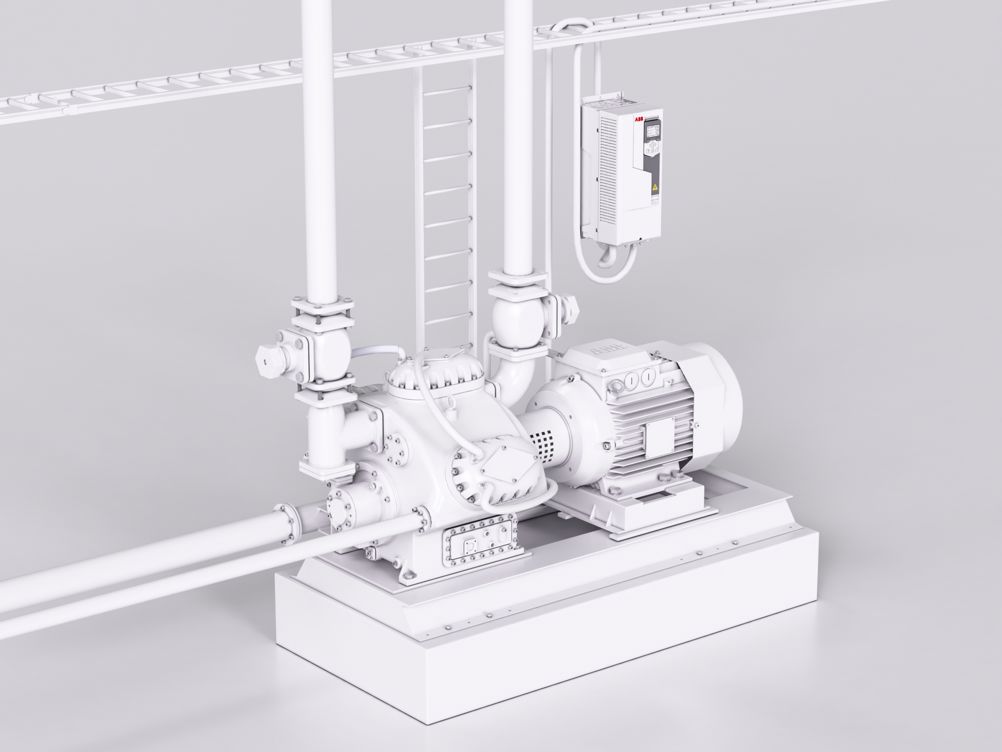Compressors have a wide range of variants, both for industrial and commercial use. For example, they are a vital component in cooling and refrigeration, which itself is essential in the food and beverage industry to ensure that food safety standards are met.
Compressors are also used for aeration as part of the wastewater treatment process. The aeration process delivers oxygen to the microbes that treat and stabilize the wastewater. This helps the microbe digest the waste and break down carbon-based, organic matter to form carbon dioxide and water.
However, there are common challenges with compressors which result in energy wastage and a lack of overall efficiency. This article outlines how the use of variable speed drives (VSDs) can help reduce these inefficiencies.
Compressor variants
Before covering the advantages of VSDs, it is worth outlining the most common types of compressors.
The first and most common is the screw compressor, typically used in refrigeration and air compression. This variant uses two rotating screws (meshed helical screws) to force compressed air through it. Here, the compression intensity is determined by the interlobe volume of the screws - the closer they are to each other, the greater the efficiency.
A piston (or reciprocal) compressor differs substantially from the screw variant. Instead of being driven by two meshing screws, this compressor utilizes multiple pistons driven by a crankshaft. The screw compressor operates at a lower temperature than the piston compressor, so is normally more durable and better suited to industrial applications.
The scroll compressor uses a rotating spiral to create compression. It can withstand contaminated inlet air more reliably than other compressor types. Its compression ratio is equal to that of screw compressors.
A high-speed centrifugal compressor is used as a refrigeration compressor for cooling and as an oil free air turbo compressor. It uses a centrifugal impeller to create low pressure and high-volume air or gas flow.
Why use drives with compressors?
Compressors used for industrial cooling and refrigeration normally use ammonia as a refrigerant. While this is effective to ensure proper refrigeration, ammonia can be dangerous if it leaks out. Alternatives like propane and CO2 are now being widely considered for commercial purposes. They represent the majority of compressors in use. While they are safer and better for the environment, they also require a greater amount of energy compared to industrial cooling compressors.
As a result, companies must find alternative ways to balance their energy costs. VSDs can aid this process by making the motors inside the compressors work more efficiently. A VSD ensures that the speed of motor operation can be adjusted to fit the exact requirements of the task in hand, rather than running at full speed at all times.
Overall, this means less energy is wasted, especially since just a small reduction in motor speed can result in a major reduction in energy usage. In a similar way, the fact that a VSD can adjust the speed of the motor - and balance the consumption of energy to meet the compressor’s output - means that less unnecessary wear and tear is inflicted on the compressor over time when compared to using a direct online motor.
Furthermore, it is important that VSDs are paired with the correct motor. Permanent and Synchronous Reluctance (SynRM) motor technology has an efficiency rating of IE5 – the highest level of efficiency currently available. Using a SynRM motor in tandem with a VSD ensures maximum durability and performance of the motor which, in turn, results in savings on maintenance and energy costs.
Importantly for operators, introducing a drive causes less wear and tear to a compressor. Because drives react instantaneously to demand, an operator doesn’t need to maintain higher discharge pressures in reserve to compensate. Keeping the pressure stable helps reduce leaks and prolongs the life of equipment, in turn reducing the lifetime costs of the system.
Despite all this, there are still large numbers of compressors that do not use VSDs. Awareness of the benefits they offer must be increased.

Drive types for compressors
ABB’s drive portfolio is suitable for a wide range of compressors. The company’s VSDs include the ACS580 general purpose drive, with built-in cooling compressor control, the ACS380 machinery drive, which is best suited for more basic compressor systems, and the ACS880 industrial drive, which is more suitable for advanced compressor control.
The ACS880 is also suitable for use with high-speed compressors, a type of compressor which is quickly becoming more widespread. Compared to the traditional way of conducting aeration in the water treatment process, a high-speed compressor paired with the ACS880 VSD can provide up to 45% better energy savings. High-speed compressors are also typically more durable because they have fewer moving parts than traditional compressors and are consequently less prone to wear and tear. This translates into reduced maintenance needs, as well as halving the lifetime cost.
Energy savings and durability
VSDs have clear efficiency and environment-related advantages for use with compressors. ABB’s wide range of drives can be paired successfully with any compressor, for any application.
About the Author
This article was written by Juha Saukko, OEM sales manager, Compressors, ABB Motion.






